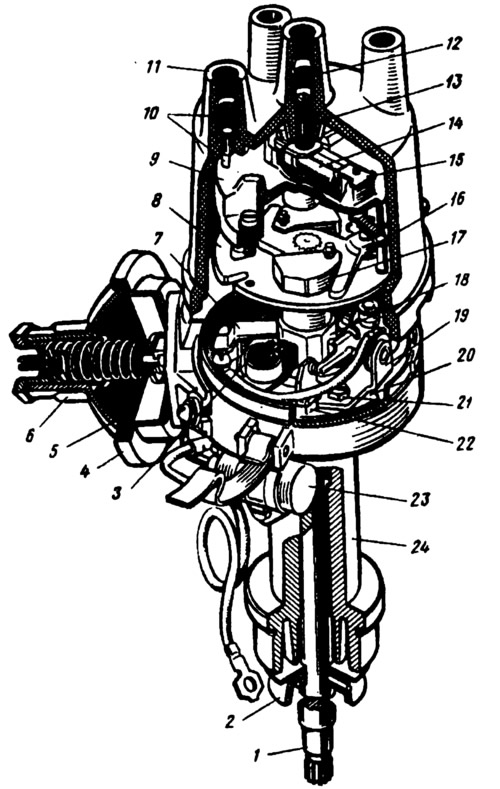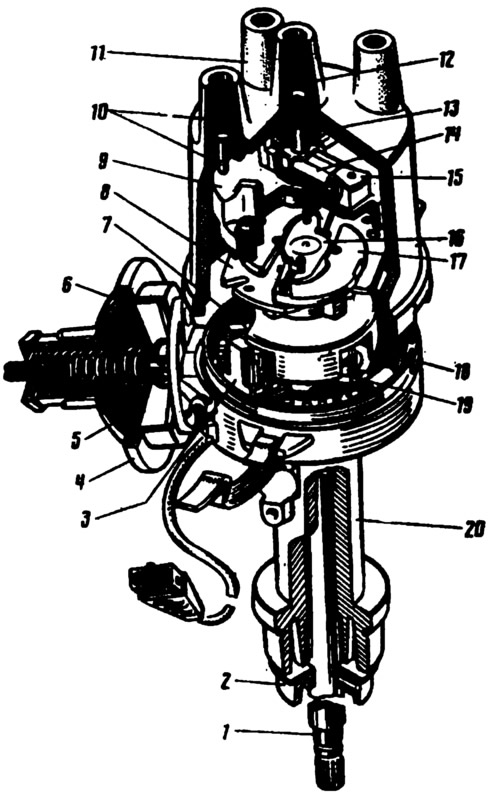
Pic. 236. Scheme of the classical (contact) ignition systems:
1 - mounting block; 2 - ignition relay; 3 - ignition switch; 4 - ignition coil; 5 - ignition distributor; 6 - spark plugs.
Since 1988, non-contact high energy ignition systems can be installed on some vehicles. It uses an electronic switch to open the low voltage circuit 5 (pic. 237), which opens and closes the circuit by turning off and on the output transistor (i.e. without contacts), and the control pulses to the switch are supplied from a proximity sensor located in the ignition distributor 6.

Pic. 237. Scheme of contactless ignition system:
1 - ignition switch; 2 - ignition relay; 3 - mounting block; 4 - ignition coil; 5 - switch; 6 - sensor-distributor ignition; 7 - spark plugs.
The ignition order in the engine cylinders is 1-3-4-2.
ignition switch consists of a housing with a locking and anti-theft device and a contact part fixed in the housing with a spring ring. The principle of operation of the anti-theft device is that after removing the key set to position 111 («Parking»), the locking rod extends from the lock body and enters the groove of the steering shaft, as a result of which the shaft is blocked.
Spark plug type A17DV for contact ignition system and A17DVR, FE65PR or FE65CPR (production of Yugoslavia) for non-contact transistor ignition system. The last candles differ from A17DV in thicker electrodes and a gap between them of 0.7-0.8 mm (instead of 0.5-0.6 mm), as well as the presence of a built-in noise suppression resistor of 4-10 kOhm.
Ignition coil type B-117A for a contact ignition system and 27.3705 for a non-contact one. Coils with an open magnetic circuit, sealed, oil-filled. Winding data differ.
Distributor (used in contact ignition system). It is a four-spark, unshielded with centrifugal and vacuum ignition timing controls. On engines 2101, 2105, ignition distributor 30.3706-01 is used (pic. 238), and with the engine 2103, which has a large cylinder block height, a distributor 30.3706 is installed. They differ only in the length of the shaft, and to distinguish the distributor 30.3706 there is a groove near the splined end of the shaft.

Pic. 238. Ignition distributor 30.3706-01:
1 - roller; 2 - oil slinger; 2 - felt; 4 - housing of the vacuum regulator; 5 - membrane; 6 - vacuum regulator cover; 7 - thrust of the vacuum regulator; 8 - base plate of the centrifugal regulator; 9 - ignition distributor rotor; 10 - side electrode with terminal; 11 - cover; 12 - central electrode with terminal; 13 - coal of the central electrode; 14 - resistor; 15 - outer contact of the rotor; 16 - centrifugal regulator plate; 17 - weight; 18 - cam breaker; 19 - contact group; 20 - movable breaker plate; 21 - screw for fastening the contact group; 22 - groove; 23 - capacitor; 24 - housing of the ignition distributor.
Ignition distributor (used in non-contact transistor ignition system). It differs from the ignition distributor for the contact ignition system in that instead of the breaker contacts, it has a proximity sensor 3 (see fig. 239), and instead of a cam, a steel screen 19 with slots is fixed on the roller. The sensor generates voltage pulses when the slotted screen passes through its groove.

Pic. 239. Sensor-distributor ignition 30.3706:
1 - roller; 2 - oil slinger; 3 - proximity sensor; 4 - housing of the vacuum regulator; 5 - membrane; 6 - vacuum regulator cover; 7 - thrust of the vacuum regulator; 8 - base plate of the centrifugal regulator; 9 - ignition distributor rotor; 10 - side electrode with terminal; 11 - cover; 12 - central electrode with terminal; 13 - coal of the central electrode; 14 - resistor; 15 - outer contact of the rotor; 16 - centrifugal regulator plate; 17 - weight; 18 - contactless sensor support plate; 19 - screen; 20 - ignition distributor sensor housing.
Switch electronic. In a non-contact transistor ignition system, it serves to convert the control pulses of a non-contact sensor into current pulses in the primary winding of the ignition coil. Switches of type 36.3734, or 3620.3734, or HIM-52 can be installed on cars (made in Hungary).
